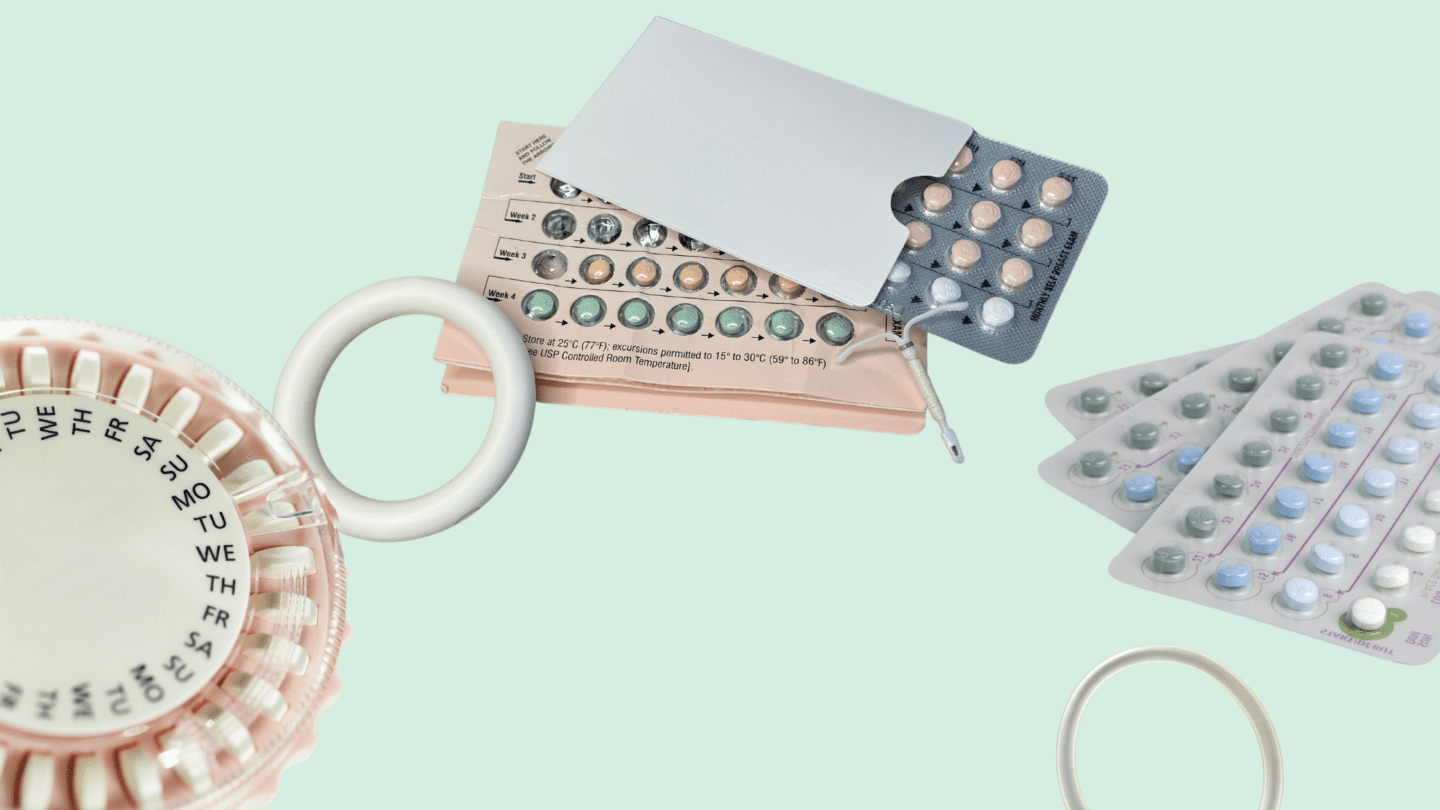Access to safe and highly effective is life changing. Research has shown this over and over again – the ripple effects of contraceptive access span educational opportunities, economic prosperity, and carry significant implications for physical and mental health. Although has been legal for over half a century, the availability of low cost or free varies dramatically from state to state, as does education around . And with the U.S. Supreme Court’s decision to overturn Roe v. Wade in June, the stakes have been raised exponentially for having an unwanted pregnancy.
In a new survey reaching more than 1,100 women in every state in the U.S., we investigated how attitudes and habits around use are changing: how they vary from state to state, among different age groups, and at different income levels. (Although some nonbinary people and trans men also use , adyn only received survey responses from users who identified as women.) We found that the sense of urgency for avoiding unwanted pregnancy has increased significantly in the post-Roe world, particularly for women living in states with heightened restrictions on abortion access.
We found that the sense of urgency for avoiding unwanted pregnancy has increased significantly in the post-Roe world, particularly for women living in states with heightened restrictions on abortion access.
Other key findings include:
- Despite gains in gender equality in our society, women continue to disproportionately bear the physical, emotional, and financial burdens of accessing .
- How much money someone makes is an indicator of whether or not they will use , or whether they will never try it at all.
- Attitudes around the importance of differ by age group, with younger women more likely to see as essential to achieving equality while women aged 30-44 more likely to list as essential to achieving professional goals.
Why We Did This Survey
At adyn, we are committed to improving access and use of highly effective methods. A key part of this mission is correcting the gap in research about issues and conditions that differentially affect people who can get pregnant. With the Dobbs decision and foreboding messages from the conservative-controlled Supreme Court, the landscape of reproductive health care access is increasingly fraught for many Americans. We designed this survey to learn more about how people are accessing today in the U.S., how that varies by age, region, and other factors, and how attitudes are changing along with the changing political climate of reproductive health care.
Five Key Findings
-
-
- Abortion bans have had a significant impact on decision-making.
- Women disproportionately bear the physical, financial, and emotional responsibility of .
- High income respondents were more likely to use prescription . Low income respondents were more likely to have never used at all.
- What state you live in and how old you are play a large part in how you learn about options.
- Some of the reasons women value vary by age, with younger women more likely to connect access to sexual pleasure and social equality.
-
1. Abortion bans have had a significant impact on decision-making.
Nearly one third of respondents (29%) said avoiding unwanted pregnancy is more important than before, given increasingly restrictive abortion laws around the country. The rate was even higher for respondents who live in states with restrictive abortion laws.
Avoiding unwanted pregnancy was the most common motivator for using . Among respondents who are at risk of unwanted pregnancy and not already on a highly effective form of , 49% said they are currently reconsidering their because avoiding unwanted pregnancy is more important than ever before.
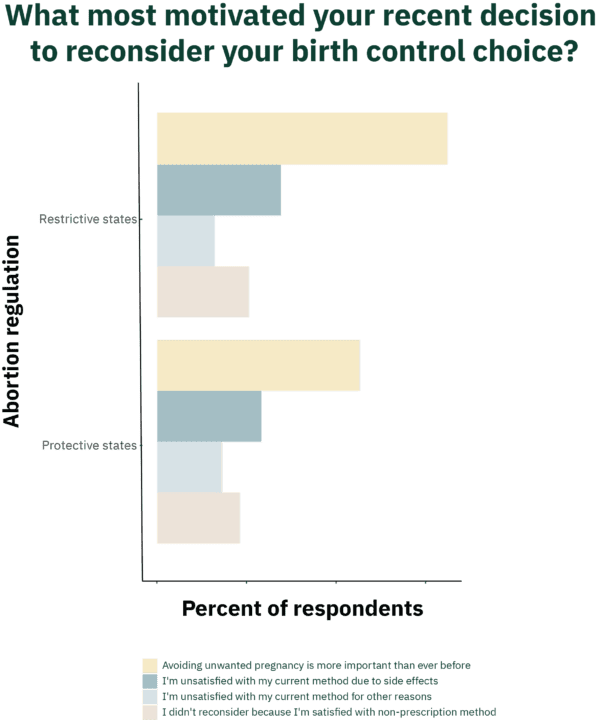
The level of abortion restrictions in a respondent’s state correlated with their motivation to reconsider their choice: the more restrictive the abortion laws, the more likely respondents were to select “avoiding unwanted pregnancy is more important than before.” Among respondents at risk of unwanted pregnancy, 52% who lived in states with restrictive abortion laws said they were reconsidering their choice, compared to 45% in states with more protective abortion laws.
Other common motivators for using included financial obstacles/goals, focusing on a specific goal, and the reversal of reproductive rights. Young adults (ages 18-29) were more likely to rank “Reversal of my Reproductive Rights” than middle-aged respondents (aged 30-44) as a motivator for using . 48% of respondents aged 18-29 ranked “Reversal of my Reproductive Rights” as a top 3 motivator, compared to 43% of respondents aged 30-44 and 31% of respondents aged 45-60.
2. Women disproportionately bear the physical, financial, and emotional responsibility of .
Despite gains made in gender equality in society, women are still disproportionately shouldering the burden of avoiding unwanted pregnancy in romantic partnerships:
- 71% of respondents said they bear all or most of the physical responsibility of .
- 63% of respondents said they bear all or most of the financial responsibility of .
- 56% of respondents said they bear all or most of the emotional responsibility of .
A higher proportion of respondents ages 30-44 said they bear all or most of the physical, financial, and emotional burden of , compared to ages 18-29 and 45-60.
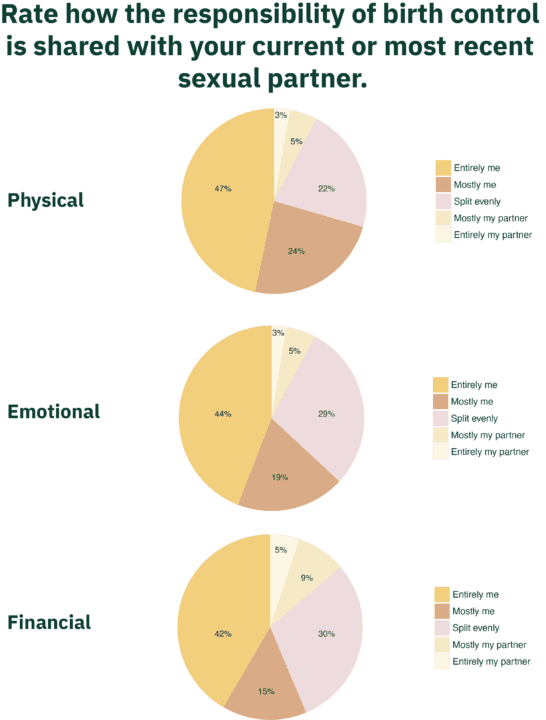
3. High income respondents were more likely to use prescription . Low income respondents were more likely to have never used at all.
Survey respondents whose household income was greater than $125,000 were more likely to be using a prescription method, or a combination of prescription and non-prescription : 54% percent of respondents with income greater than or equal to $125,000 reported using these methods, as compared to 49% of people with income below $125,000. Respondents who made more than $125,000 were also less likely to say they had never used and don’t plan to than those who made under $125,000 (14% for the former, 5% for the latter).
Like what you’re reading? Get the latest straight to your inbox 💌
4. What state you live in and how old you are play a large part in how you learn about options.
Women who live in states with restrictive abortion laws get information about in a health care setting less frequently than women in states with protective laws. Women in states with restrictive laws tended to rely on information gained in Sex Ed class about more than women in states with protective laws, even though many states that have abortion bans also have minimal standards for Sex Ed in schools or mandate abstinence-only curricula.
Age played a major role in what type of source respondents tended to use to access information about . Younger respondents, aged 18-29, tended to use online sources for learning about , compared to respondents in older age groups. Younger respondents also used social media apps like Instagram and TikTok to learn about more frequently than older respondents.
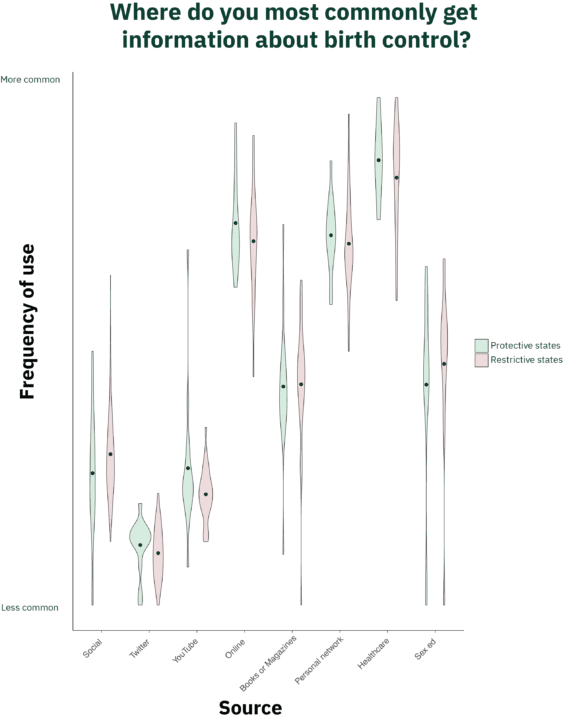
This “violin plot” summarizes how often respondents used different sources to learn about , comparing the responses from people who live in states with protective vs. restrictive abortion laws. The width of the violin reflects how frequently respondents used that source, with a longer violin indicating that the frequency of use varied more widely among respondents, and a shorter, fatter violin indicating more responses all at the same frequency of use. The average frequency of use for each source is displayed with a dark green dot. The category “Social” includes Facebook, Instagram, and TikTok.
5. Some of the reasons women value vary by age, with younger women more likely to connect access to sexual pleasure and social equality.
While all age groups agreed that is essential to achieving personal and family goals, the reasons that respondents value varied by age in other categories. Young women, aged 18-29, were most likely to list as essential to achieving sexual pleasure. Middle aged women, aged 30-44, were twice as likely as 18-29 to list as essential to achieving their mental health goals, and were the most likely to list as essential to achieving their professional goals (33%). Younger women (18-29) were more likely than other groups to list as essential to achieving equality (31%).
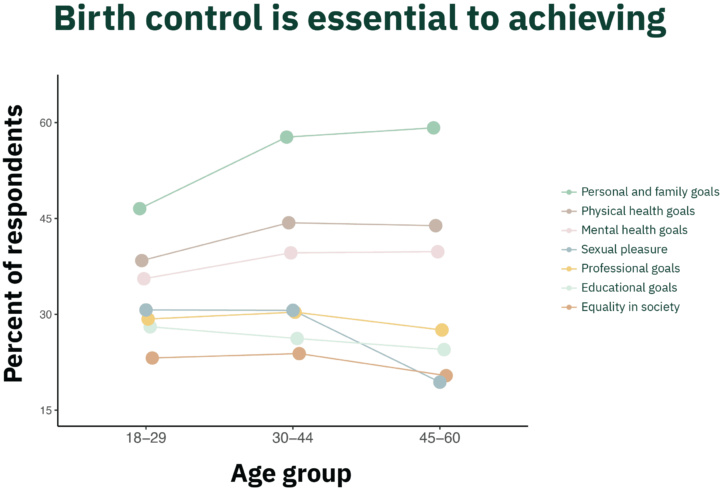
Conclusion
The right to access safe and highly effective is a key component of a free and just society, and it may be in jeopardy. With the politicized climate of reproductive health care, there is much work to be done to ensure that people are empowered to decide for themselves when they would and would not like to get pregnant. Our survey shows that women continue to bear the disproportionate responsibility for avoiding unwanted pregnancies and accessing . This may be shifting somewhat in the younger generation, as are attitudes about the reasons why is so important in the first place. However, many of the conditions of access are tied to geography, as are the fears and level of anxiety for what may happen if an unwanted pregnancy occurs.
Contraceptive access is not assured for our future, it’s up to us to take action and protect it.
With the threat of future Supreme Court actions limiting contraceptive access, along with efforts in some conservative states to criminalize and conflate with abortion, our future access to contraceptives is on the line. Civic engagement is key: voting and working to support community and statewide efforts and organizations to promote safe and accessible reproductive health care can make all the difference. Contraceptive access is not assured for our future, it’s up to us to take action and protect it.
Methods
This survey used a combination of multiple choice, checkbox, ranking, and rating scale questions in order to gain insights about use and attitudes around . This survey was designed and distributed through SurveyMonkey, with the majority of responses collected from the SurveyMonkey Audience. The remainder came from organic outreach through email, social media, and other online tools. There were no ads taken out to promote the survey. The survey targeted women ages 18-48, however we did receive responses from a small number of people outside of that age range who received the survey through organic outreach. Survey data was analyzed using R (Rstudio version 0.99.441). Survey responses were collected in August and September 2022.
Participants
The survey yielded 1,324 responses. Of these, 172 were filtered out based on an initial screening question (“I’ve never used and I don’t plan to”). The pool of remaining 1,152 respondents were primarily young and middle-aged adults, with 51% between the ages of 30 and 44, and 37% between the ages of 18 and 29. Only 7% of respondents were between ages 45 and 60. All respondents identified as women.
Geographically, respondents were fairly evenly distributed across different regions of the U.S., from states with a wide range of policies and laws when it comes to reproductive healthcare access. The largest number of respondents were from California, with 143 respondents; New York, with 75 respondents; Florida, with 73 respondents; and Texas, with 69 respondents.
The people who responded to the survey tended to be middle and lower income, with 57% of respondents making less than $75,000 per year. Only 13% of respondents made more than $125,000 per year, and 95 respondents opted not to answer the question about their income.
Data was not collected on the race, ethnicity, primary language, health insurance and citizenship status of respondents.
Are you registered to vote? 🗳
Check your voter registration status with our partner Vot-ER.



